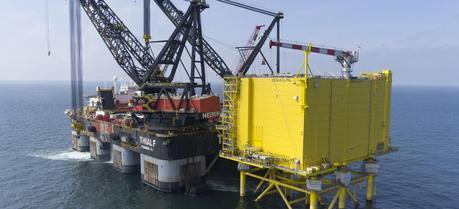 DolwinAlpha is set, now the work begins inside the station. (Credit: ABB Group)
DolwinAlpha is set, now the work begins inside the station. (Credit: ABB Group)Yesterday we reported the installation of the 567MW HelWin1 North Sea converter station by Siemens. Now ABB, a multinational corporation operating mainly in the power and automation technology areas, has installed the world’s highest-voltage offshore converter station in the North Sea. Alternating current electricity generated in three wind farms off the coast of Germany will be converted on the platform into high-voltage direct current (HVDC) for transmission to the mainland.
The 320 kilovolts converter station has an 800 megawatt power transmission capacity making it the world’s most powerful installation of its kind.
In a three-day operation, the 9,300 metric tonne platform (topside) including the converter station was transported offshore by barge around 75 km off the German coast. It was then lifted by the world’s largest crane vessel Thialf and positioned on top of the already installed jacket.
“Putting such a huge platform in place is one of the most delicate operations in the delivery of an offshore transmission link, requiring strong cooperation between the many stakeholders involved” said Brice Koch, Head of ABB’s Power Systems division. “This is an important project milestone in the delivery of this HVDC offshore wind connection and we are pleased it went smoothly.”
ABB was awarded the turnkey responsibility for system engineering, design, supply and installation of the offshore wind connection by TenneT, a leading European transmission system operator. The project scope includes the offshore converter station, the sea and land cable systems, and the onshore converter station.The system features the latest generation of ABB power semiconductors, with increased performance that ensures higher availability and lower losses.
The DolWin 1 offshore wind connection is expected to avoid 3 million tonnes of carbon dioxide emissions per year by replacing fossil-fuel based generation.

